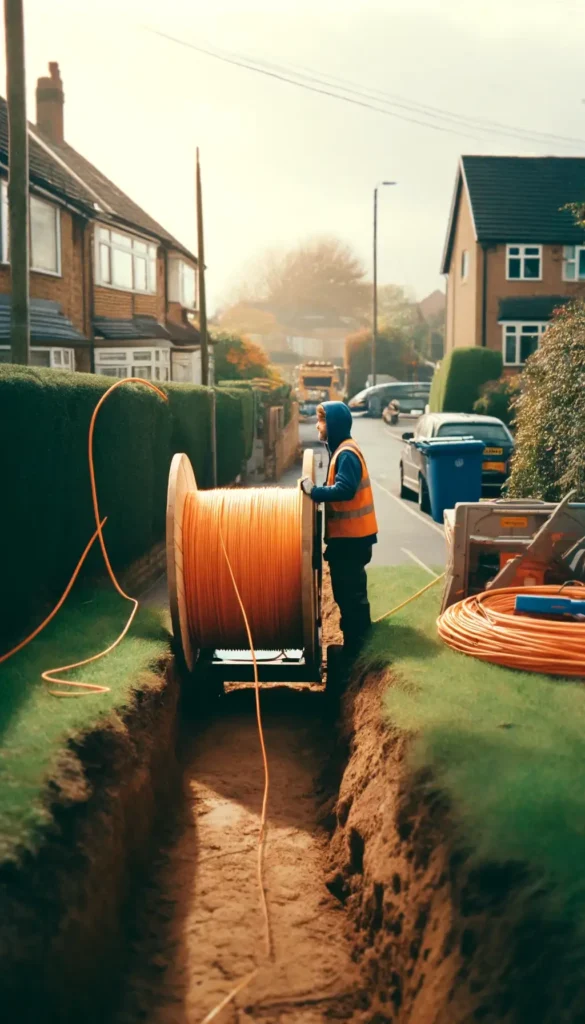As technology advances, our need for faster, more reliable internet connections grows. Geospatial Net is your one-stop shop for design, planning, survey, as-built documentation, GIS and CAD system design, data analytics, and system integration. Our expertise ensures properly planned network, and up to date documentation for the fiber infrastructure, making future maintenance seamless.
We aim to share knowledge about constructing fiber-optic networks, helping companies and communities understand the process and set realistic expectations. By understanding the challenges and complexities involved in FTTH construction, everyone can better appreciate the efforts to build robust networks that support community growth and facilitate faster digital transformation. Our goal is to build future-proof networks and create lasting documentation. This blog post will guide you through the journey of fiber-optic network construction, making it accessible for both novices and experts.
1. Planning and Surveying
The journey begins with network surveying and meticulous planning. We conduct comprehensive surveys to assess the feasibility of installing fiber infrastructure (aerial and underground). This involves evaluating existing infrastructure, identifying potential obstacles, and determining the optimal routes for fiber cables. Advanced GIS (Geographic Information System) and CAD (Computer-Aided Design) tools are utilized to create detailed maps and models. These tools help visualize the network layout, analyze geographical features, and plan routes that minimize disruption and cost.
Detailed Bill of Materials (BoM) and Bill of Quantity (BoQ) documents are provided, ensuring that all materials and quantities are accounted for, helping to manage costs and logistics effectively.
Additionally, many projects require precise infrastructure positioning, so we use a variety of surveying equipment to collect data with centimeter level accuracy, including GNSS equipment with RTK capabilities, LIDAR, and mapping cameras. The field data collection process includes pole location and mid-span location coordinates, photos, pole height/class information, pole ID number, ground-line circumference measurements, pole lean measurements, guy and anchor information, as well as documentation of any equipment present and any repair and maintenance required. This detailed information ensures that the make-ready work on poles is properly documented and managed, which is crucial for aerial fiber installations.

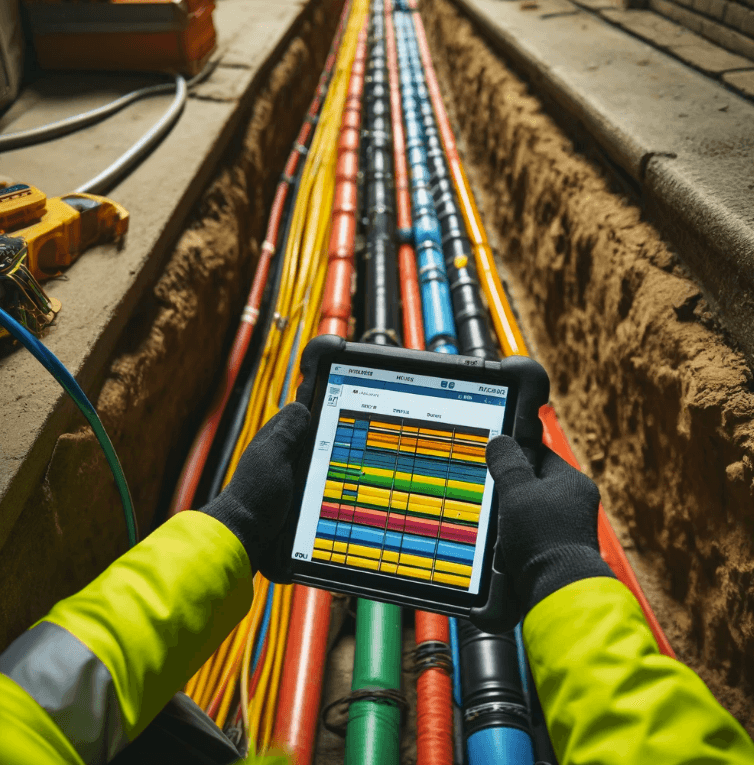

2. Permitting and Approvals
Before construction can commence, obtaining the necessary permits and approvals from local authorities is essential. This step ensures compliance with regulations and standards governing the installation of telecommunication infrastructure. Navigating the permitting process involves meeting all requirements, securing approvals in a timely manner, and ensuring that all documentation complies with local regulations.
In some countries, such as the US, this process can be particularly complex due to the various layers of federal, state, and local regulations. It often requires coordination with multiple agencies and stakeholders, including municipal governments, environmental agencies, and utility companies. Successfully managing this process involves a thorough understanding of the regulatory landscape, meticulous preparation of application materials, and proactive communication with regulatory bodies to address any concerns or requirements they may have.
3. Fiber Cable Installation
Once planning and permitting are complete, the actual construction begins. This involves burying or installing fiber-optic cables along predetermined routes. Fiber cables are usually buried underground through trenching or using existing conduits. During this phase, locators identify existing utilities to prevent damage. Crews and equipment work diligently to lay the fiber plant.
Common trenching methods for telecom installations include:
- Open Trenching: Digging a trench along the entire route. Suitable for less dense infrastructure.
- Directional Drilling (HDD): Installing cables without surface disruption. Ideal for urban areas.
- Microtrenching: Creating narrow, shallow trenches. Minimizes urban disruption.
- Plowing: Quickly laying cables in rural areas using a cable plow.
Aerial installation may also be used, where cables are strung along utility poles. This method can be faster and less expensive, especially in areas with existing poles, but it requires detailed make ready documentation and more extensive survey.
After laying the cables, they are blown or jetted through conduits using compressed air, ensuring quick installation with minimal stress, ideal for long-distance placements.
These diverse methods ensure that fiber installation is tailored to the project’s specific requirements, terrain, and urban density, resulting in a reliable and efficient network infrastructure.
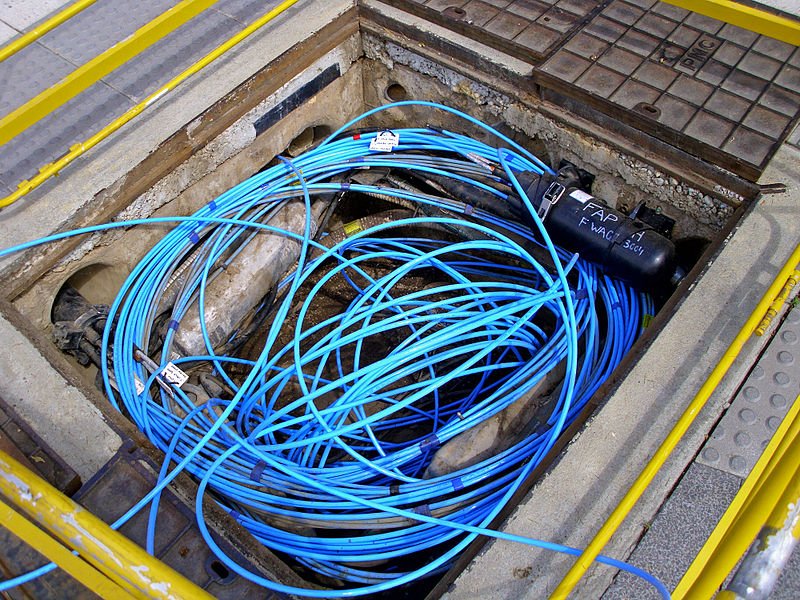
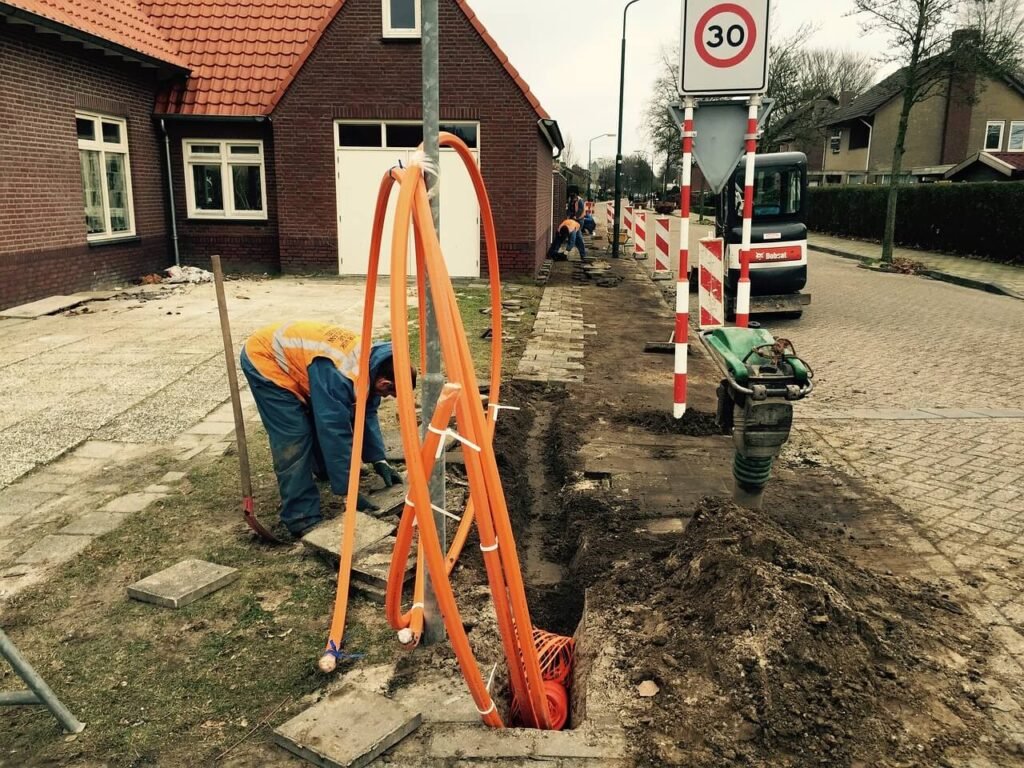
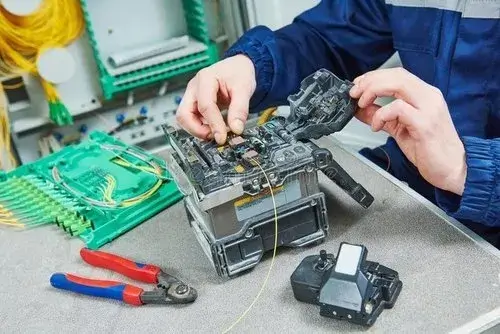
4. Splicing and Connection
After the fiber-optic cables are laid, the next step is splicing—joining individual fiber strands together. This process requires highly trained technicians using specialized equipment to ensure precise connections. Splicing is critical to maintaining the integrity and efficiency of the fiber-optic network. Proper splicing ensures that the network can deliver high-speed, reliable internet to end users. Detailed splicing plans and schedules are developed to manage the splicing process efficiently.
5. Testing and Quality Assurance
To guarantee optimal performance, the installed fiber-optic network undergoes rigorous testing. Technicians use advanced testing equipment to measure signal strength, detect potential issues, and ensure that the network meets industry standards. This phase is crucial for delivering the high-speed, low-latency connectivity that fiber-optic internet provides.
Our team also develops solutions to manage the As-Built documentation, along with the reports from the measuring equipment used for network testing, maintaining one centralized location for all documentation.

6. Connecting to Customer Homes
Once the fiber infrastructure is in place and thoroughly tested, the final step is connecting individual homes to the network. When a customer places an order for service, technicians will install a network termination point at each residence, allowing access to high-speed fiber-optic internet.
What Customers Can Expect:
Scheduling Installation: After placing an order, customers will be contacted to schedule an installation appointment. Technicians will visit the home to perform the necessary setup.
Home Access: Technicians will need access to both the inside and outside of the home to install the necessary equipment, including a network termination point, which connects the fiber line to the home’s internal network.
Minimal Disruption: The installation process is designed to be as quick and unobtrusive as possible. Technicians will work efficiently to minimize any disruption to your daily routine.
Testing and Activation: Once the equipment is installed, technicians will conduct tests to ensure everything is working correctly. They will verify signal strength and connectivity to ensure you receive the high-speed internet service you ordered.
Customer Education: Technicians will provide a brief overview of the equipment and answer any questions customers might have about their new fiber-optic service.
Understanding the Benefits of FTTH Over Coax, Wireless and DSL
Fiber to the Home (FTTH) offers numerous benefits compared to legacy technologies like coax, hybrid fiber-coax (HFC), wireless solutions, and DSL. As highlighted in previous posts, the primary advantage of FTTH is that optical fiber supports faster speeds and greater bandwidth. Optical fiber also “future-proofs” the network, accommodating significantly greater performance capabilities well into the future. The limiting factor in a fiber network isn’t the fiber itself but the capabilities of the devices and transmission technology. As these technologies advance, optical fiber will continue to meet demands for the foreseeable future.
Additional benefits of optical fiber over legacy systems such as copper-based coax and DSL include:
- Greater resistance to environmental changes
- Immunity to electromagnetic interference (EMI)
- Cost-effectiveness
- Lightweight
While fiber is now the primary transmission medium for most communications networks, it is often used for major routes, with the “last mile” segment—from main hubs to homes—still using coax in many instances. However, given its advantages, newer networks are increasingly bypassing legacy technologies and installing fiber and fiber-based devices throughout the entire network or as far as possible within the project’s scope.
Final Words
Geospatial Net not only designs and plans fiber networks but also develops systems for real-time data collection and intelligence. Our solutions provide real-time data from construction sites and survey teams, which is crucial for monitoring progress and ensuring accuracy. Interactive maps, dashboards, and automation tools streamline the entire process, making project management more efficient and transparent. Network inventory and asset management systems help keep track of all network components, ensuring maintenance and upgrades are easily managed.
The process of bringing fiber-optic internet to a neighborhood involves careful planning, precise construction, and thorough testing. Geospatial Net is dedicated to ensuring that every step is executed with the highest level of expertise. Our team’s extensive experience in FTTH Planning, Project Management, As-Built Documentation, and the development of custom solutions for project monitoring and tracking with GIS maps, dashboards, and automation sets us apart. We are committed to building the future of connectivity, one neighborhood at a time. Whether you’re a resident eagerly awaiting high-speed internet or an industry expert looking for detailed planning and management solutions, Geospatial Net has the knowledge and tools to deliver exceptional results.
